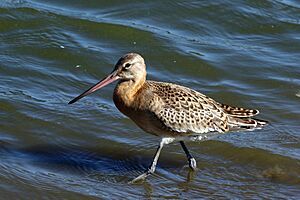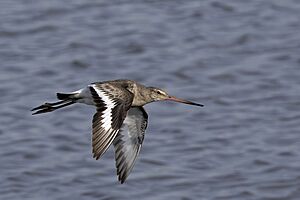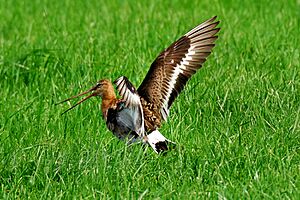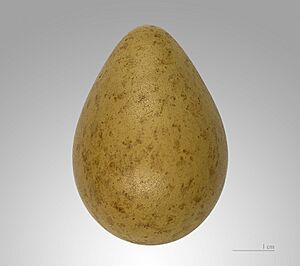Black-tailed godwit facts for kids
Quick facts for kids Black-tailed godwit |
|
|---|---|
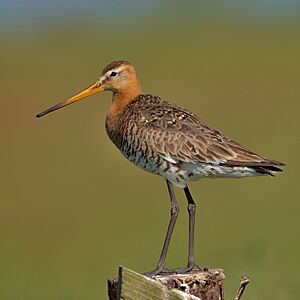 |
|
| Breeding plumage | |
| Conservation status | |
| Scientific classification | |
| Subspecies | |
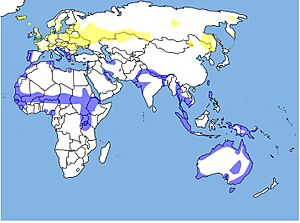 |
|
| Range of L. limosa Breeding range Resident range Wintering range | |
| Synonyms | |
|
The black-tailed godwit (Limosa limosa) is a large shorebird with long legs and a long bill. It was first described by Carl Linnaeus in 1758. This bird is part of the Limosa group, which includes other godwits.
There are four types, or subspecies, of black-tailed godwits. All of them have an orange head, neck, and chest when they are ready to breed. In winter, their feathers turn a dull grey-brown. You can always spot their special black and white stripes on their wings.
These birds breed in places like Iceland, Europe, and parts of central Asia. When winter comes in the northern hemisphere, black-tailed godwits fly to warmer areas. They can be found in places like India, Australia, New Zealand, western Europe, and west Africa. They like to breed in wet areas like fens, lake edges, and damp meadows. In winter, they prefer estuaries, swamps, and flooded areas. Unlike the similar bar-tailed godwit, they are more often found inland near freshwater.
Scientists believe there are about 634,000 to 805,000 black-tailed godwits in the world. Because their numbers are decreasing, they are listed as Near Threatened. The black-tailed godwit is also the national bird of the Netherlands.
Contents
About the Black-tailed Godwit
The black-tailed godwit was officially named by the Swedish scientist Carl Linnaeus in 1758. He called it Scolopax limosa. Now, it belongs to a group of birds called Limosa, which was named by Mathurin Jacques Brisson in 1760. The name Limosa comes from a Latin word meaning "muddy," because these birds often live in mud. The English name "godwit" was first used around 1416. People think it sounds like the bird's call.
There are four main types, or subspecies, of black-tailed godwits:
- L. l. islandica – This type breeds mostly in Iceland. It also breeds on the Faeroe Islands, Shetland, and Lofoten Islands. It has a shorter bill and legs, and more reddish-orange feathers on its belly compared to the limosa type.
- L. l. limosa – This is the European black-tailed godwit. It breeds from western and central Europe all the way to central Asia and parts of Russia. Its head, neck, and chest are a light orange color.
- L. l. melanuroides – This is the Asian black-tailed godwit. It breeds in Mongolia, northern China, and eastern Russia. Its feathers look similar to the islandica type, but this bird is much smaller.
- L. l. bohaii – This type is thought to breed in the Russian Far East. In winter, it lives in northeast China, Hong Kong, Vietnam, and Malaysia.
What Does a Black-tailed Godwit Look Like?
The black-tailed godwit is a large wader bird. It has a long bill, which can be about 7.5 to 12 centimeters (3 to 4.7 inches) long. It also has a long neck and long legs. When they are breeding, the base of their bill is yellowish or orange-pink, with a dark tip. In winter, the bill base turns pink. Their legs are dark grey, brown, or black.
Males and females look similar, but during breeding season, the male's chest, neck, and head are brighter orange. In winter, adult black-tailed godwits have a plain brown-grey chest and back. This is different from the bar-tailed godwit, which has streaks on its back. Young godwits have a pale orange color on their neck and chest.
When they fly, you can easily see their bold black and white wings and white rump. On the ground, it can be hard to tell them apart from the similar bar-tailed godwit. However, the black-tailed godwit has a longer, straighter bill and longer legs, which helps identify it. They are similar in size to bar-tailed godwits but stand taller.
From its bill to its tail, a black-tailed godwit is about 42 cm (16.5 inches) long. Its wingspan can be from 70 to 82 cm (27.5 to 32 inches). Males weigh around 280 grams (9.9 ounces), and females weigh about 340 grams (12 ounces). Females are about 5% larger than males, and their bills are 12–15% longer.
Their most common call sounds like a loud weeka weeka weeka.
Sadly, many young black-tailed godwits do not survive their first year.
Where Do Black-tailed Godwits Live?
Black-tailed godwits breed in different areas from Iceland to eastern Russia. They like to breed in wet places like river valleys, flooded areas near large lakes, and damp grasslands. Many European godwits now use other habitats too. These include wet grasslands, coastal marshes, and wet areas near fishponds. They can even breed in sugar beet, potato, and rye fields in the Netherlands and Germany.
In spring, black-tailed godwits mostly feed in grasslands. After breeding, and during winter, they move to muddy estuaries. In Africa, they gather in swamps, flooded areas, and rice fields. In India, they use inland pools, lakes, and marshes.
Godwits from Iceland usually spend winter in the United Kingdom, Ireland, France, and the Netherlands. Some fly even further to Spain, Portugal, and Morocco. Birds from western Europe fly south to Morocco, then to Senegal and Guinea-Bissau. Those from eastern Europe migrate to Tunisia and Algeria, then to Mali or Chad. Young birds from Europe often stay in Africa after their first winter. They return to Europe when they are two years old. Asian black-tailed godwits spend winter in Australia, Taiwan, the Philippines, Indonesia, and Papua New Guinea.
Black-tailed godwits are much more likely to be found in inland wetlands than the bar-tailed godwit, which prefers coastal areas. They migrate in large groups to western Europe, Africa, south Asia, and Australia. Even though you can see this bird in Ireland and Great Britain all year, they are not the same birds. The breeding birds leave in autumn, but larger Icelandic godwits arrive for the winter. Sometimes, these birds are even seen in the Aleutian Islands and, rarely, on the Atlantic coast of North America.
How Do Black-tailed Godwits Behave?
Breeding
Black-tailed godwits are mostly monogamous, meaning they usually have one partner. Even if they spend winter apart, pairs often meet up again on their breeding grounds within a few days of each other. If one partner doesn't show up, they might find a new mate.
They build their nests in groups, but not too close together. Unpaired males will fly around and show off to attract a female. They make several shallow nests on the ground, usually in short plants. Once the eggs are laid, they protect an area of about 30 to 50 meters (98 to 164 feet) around the nest. The parents might hide the eggs with plants while they sit on them.
A female lays one set of three to six eggs. The eggs are olive-green to dark brown, about 55 x 37 millimeters (2.2 x 1.5 inches) in size, and weigh about 39 grams (1.4 ounces). Both parents take turns sitting on the eggs for 22–24 days. The young chicks are born with soft downy feathers and can move around soon after hatching. The parents keep them warm when they are small and at night when it's cold. After hatching, the chicks are led away from the nest to places like marshes and mudflats. The young birds learn to fly after 25–30 days.
The number of chicks that survive depends on how warm it is in spring. However, big events like a volcanic eruption can sometimes cause all the breeding to fail.
Food and Feeding
Black-tailed godwits mainly eat small animals without backbones, called invertebrates. In winter and during migration, they also eat water plants. During the breeding season, they eat beetles, flies, grasshoppers, dragonflies, mayflies, caterpillars, worms, and snails. Sometimes, they even eat fish eggs, frogspawn, and tadpoles.
When they are in water, they often push their long bills deep into the mud to find food. They can do this up to 36 times a minute, sometimes even putting their whole head underwater! On land, they also poke their bills into soft ground and pick up food from the surface.
Black-tailed Godwits and People
In Europe, black-tailed godwits are only hunted in France. About 6,000 to 8,000 birds are hunted there each year. This adds pressure to their population in western Europe. Because of this, the European Commission has a plan to help protect the species in its member countries.
In England, black-tailed godwits used to be a very popular food. Sir Thomas Browne (who lived from 1605 to 1682) said they were "the daintiest dish in England." Old names for the bird included Blackwit, Whelp, Yarwhelp, Shrieker, Barker, and Jadreka Snipe. In Icelandic, the bird is called Jaðrakan.
How Are Black-tailed Godwits Doing?
There are an estimated 634,000 to 805,000 black-tailed godwits worldwide. Their habitat covers about 7,180,000 square kilometers (2,770,000 square miles). In 2006, BirdLife International listed this species as Near Threatened. This is because their numbers dropped by about 25% in the 15 years before that.
The black-tailed godwit is also protected by the Agreement on the Conservation of African-Eurasian Migratory Waterbirds (AEWA). In 2024, the L. limosa subspecies was listed as Endangered under Australia's EPBC Act.



